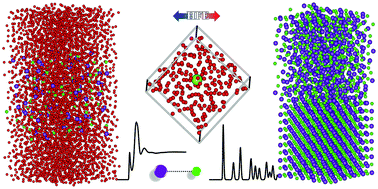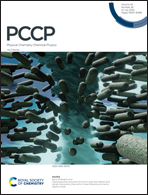Impacts of targeting different hydration free energy references on the development of ion potentials†
Abstract
Hydration free energy (HFE) as the most important solvation parameter is often targeted in ion model development, even though the reported values differ by dozens of kcal mol−1 mainly due to the experimentally undetermined HFE of the proton ΔG°(H+). The choice of ΔG°(H+) obviously affects the hydration of single ions and the relative HFE between the ions with different (magnitude or sign) charges, and the impacts of targeted HFEs on the ion solvation and ion–ion interactions are largely unrevealed. Here we designed point charge models of K+, Mg2+, Al3+, and Cl− ions targeting a variety of HFE references and then investigated the HFE influences on the simulations of dilute and concentrated ion solutions and of the salt ion pairs in gas, liquid, and solid phases. Targeting one more property of ion–water oxygen distances (IOD) leaves the ion–water binding distance invariant, while the binding strength increases with the decreasing (more negative) HFE of ions as a result of a decrease in ΔG°(H+) for the cation and an increase in ΔG°(H+) for the anion. The increase in ΔG°(H+) leads to strengthened cation–anion interactions and thus to close ion–ion contacts, low osmotic pressures, and small activity derivatives in concentrated ion solutions as well as too stable ion pairs of the salts in different phases. The ion diffusivity and water exchange rates around the ions are simply not HFE dependent but rather more complex. Targeting both the aqueous IOD and salt crystal properties of KCl was also attempted and the comparison between different models indicates the complexity and challenge in obtaining a balanced performance between different phases using classical force fields. Our results also support that a real ΔG°(H+) value of −259.8 kcal mol−1 recommended by Hünenberger and Reif guides ion models to reproduce ion–water and ion–ion interactions reasonably at relatively low salt concentrations. Simulations of a metalloprotein show that a relatively more positive ΔG°(H+) for Mg2+ model is better for a reasonable description of the metal binding network.



 Please wait while we load your content...
Please wait while we load your content...